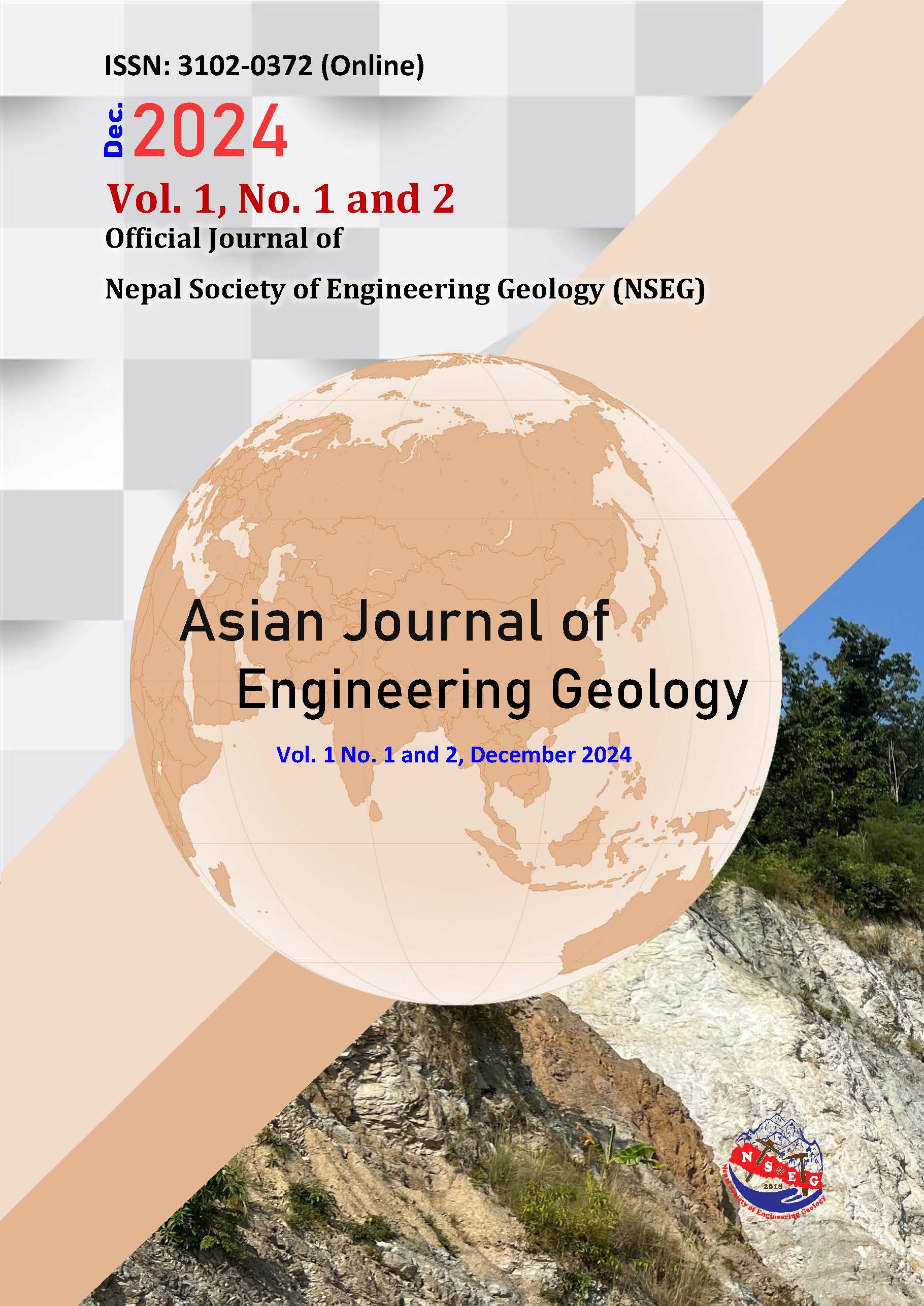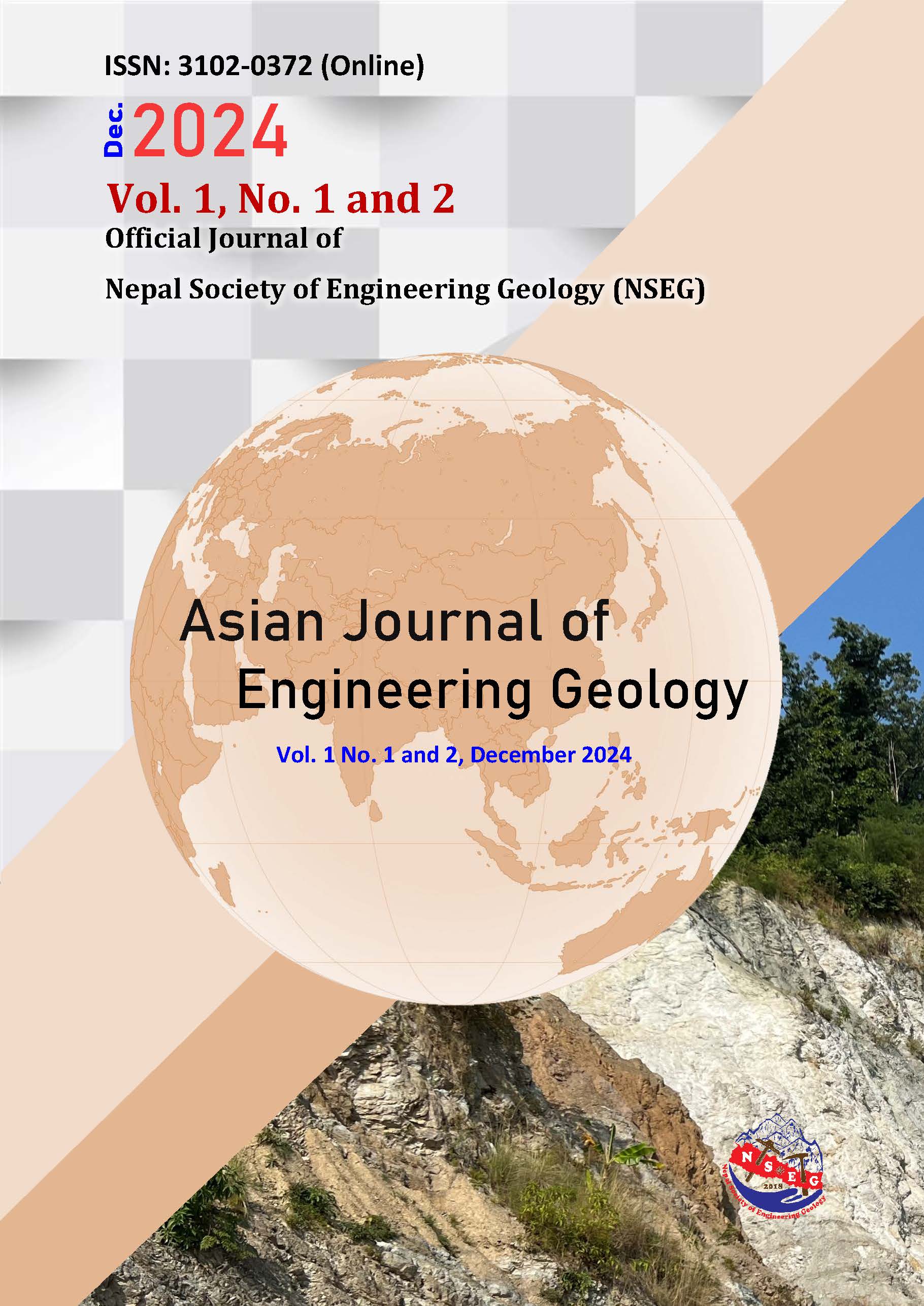Deformation Study of Gharkhola Hydroelectric Project Tunnel Emphasis on Squeezing, West Central Nepal
DOI:
https://doi.org/10.64862/ajeg.112.04Keywords:
Deformability, Squeezing, Numerical modelling., Support pressureAbstract
This research investigates the deformation and squeezing phenomena in the headrace tunnel of the Gharkhola Hydroelectric Project in Nepal, emphasizing the challenges posed by weak rock masses in the Himalayan region. The study employs a multifaceted methodology, integrating empirical, semi-analytical, and numerical approaches to evaluate the deformation modulus (Em) and predict tunnel stability. Utilizing regression analysis, the sensitivity of (Em) and predict tunnel stability. Utilizing regression analysis, the sensitivity of Em to rock mass classification Q, GSI, and RMR is scrutinized, revealing that euations proposed by Barton (2002), Hoek and Diederichs (2006), and Gokceoglu et al. (2003) exhibit the least sensitivity to rock mass variability, rendering them particularly efficacious for deformability estimation. The analysis identifies severe squeezing conditions in specific tunnel sections, with maximum wall closure reaching 0.432803 meters at an overburden height of 134 meters. Empirical and semi-analytical methods, including Singh et al. (1992) and Hoek and Marinos (2000), corroborate the prevalance of squeezing, while finite element modelling quantifies deformation, validating field observations. The study underscores the imperative of employing diverse methodologies to corroborate rock mass parameters, thereby enhancing the accuracy of squeezing predictions. The findings advocate for meticulous parameter selection and interdisciplinary validation to mitigate instability in tunneling projects within geologically complex terrains.
References
Barla G. (2016). Applications of numerical methods in tunnelling and underground excavations: Recent trends (Keynote Paper). https://doi.org/10.1201/9781315388502-7.
Barton N. (1983). Application of Q system, index tests to estimate shear strength and deformability of rock masses. In: Proceedings of the International Symposium on Engineering Geology and Underground Construction, Lisbon, 51–70.
Barton N. (1995). The influence of joint properties in modelling jointed rock masses. Keynote Lecture, 8th ISRM Congress, Tokyo.
Barton N. (2002). Some new Q-value correlations to assist in site characterization and tunnel design. International Journal of Rock Mechanics and Mining Sciences, v. 39, 185-216. https://doi.org/10.1016/S1365-1609(02)00011-4
Barton N., Lien R., Lunde J. (1974). Engineering classification of rock masses for the design of tunnel support. Rock Mechanics 6(4):189–236. https://doi.org/10.1007/BF01239496
Beiki M., Bashari A., Majdi A. (2010). Genetic programming approach for estimating the deformation modulus of rock mass using sensitivity analysis by neural network. International Journal of Rock Mechanics and Mining Sciences, 47 (7), 1091-1103.
Bieniawski Z. T. (1973). Engineering classification of jointed rock masses. Transactions of the South African Institution of Civil Engineers, v. 15, pp. 335-342.
Carvalho J. (2004). Estimation of rock mass modulus, In Hoek E. and Diederichs M. S. (2006): Empirical estimation of rock mass modulus International Journal of Rock Mechanics and Mining Sciences, 43, 203-215.
Diederichs M. S., and Kaiser P. K. (1999). Stability of large excavations in laminated hard rock masses: The voussoir analogue revisited. International Journal of Rock Mechanics and Mining Sciences, 36 (1), 97–117. https://doi.org/10.1016/S0148-9062(98)00179-4
Goel R. K. (1994). Correlations for predicting support pressures and closures in tunnels, (Ph. D. thesis), Nagpur University, India, Unpublished, 43 p.
Goel R. K., Jethwa J. L., and Paithankar A. G. (1995). An empirical approach for predicting ground condition for tunnelling and its practical benefits. In Proceedings of the 8th International Congress on Rock Mechanics, 693–698.
Gokceoglu C., Sonmez H. and Kayabasi A. (2003). Predicting the deformation moduli of rock masses. International Journal of Rock Mechanics and Mining Sciences - INT J ROCK MECH MINING SCI. 40. 701-710. https://doi.org/10.1016/S1365-1609(03)00062-5.
Grimstad E. and Barton N. (1993). Updating the Q-system for NMT. In: Proceedings of the international symposium on sprayed concrete, Fagernes. Norway Concrete Association, Oslo, 20-58.
Hoek E. and Brown E. T. (1980a). Underground excavations in rock. Institution of Mining and Metallurgy.
Hoek E. and Brown, E. T. (1980b). Empirical strength criterion for rock masses. Journal of the Geotechnical Engineering Division, 106 (GT9), 1013–1035.
Hoek E. and Brown E. T. (1997). Practical estimates of rock mass strength. International Journal of Rock Mechanics and Mining Sciences, 34 (8), 1165–1186. https://doi.org/10.1016/S1365-1609(97)80069-X
Hoek E. and Diederichs M. S. (2006). Empirical estimation of rock mass modulus. International Journal of Rock Mechanics and Mining Sciences, 43 (2), 203–215. https://doi.org/10.1016/j.ijrmms.2005.06.005
Hoek E. and Marinos P. (2000). Predicting tunnel-squeezing problems in weak heterogeneous rock masses. Tunnels and Tunneling International, 32 (11), 45-51.
Jaiswal A., Shrivastva B. K. and Singh P. K. (2023). Numerical modelling for support design and stability analysis of a tunnel in weak rock mass. Journal of Mining and Environment, 14 (1), 123-138. Retrieved from https://www.researchgate.net/publication/337679951, Accessed on 22 June 2023.
Kayabasi A., Gokceoglu C. and Ercanoglu M. (2003). Estimating the deformation modulus of rock mass: a comparative study. International Journal of Rock Mechanics and Mining Sciences, 40, 55-63. https://doi.org/10.1016/S1365-1609(02)00112-0
Khadka S. S., Pathak D. and Panta S. R. (2019). Numerical analysis of tunnel squeezing and support design: A case study from Nepal. Journal of Rock Mechanics and Geotechnical Engineering, 11 (6), 1266–1282. https://doi.org/10.1016/j.jrmge.2019.07.005
Mitri H. S., Edrissi R. and Henning J. (1994). Finite element modeling of rock mass deformability. Paper presented at the 1st North American Rock Mechanics Symposium, Austin, TX.
Mushahary D. R., Singh T. N. and Das R. (2020). Stability analysis of a tunnel in the Himalayan region: A finite element approach. Geotechnical and Geological Engineering, 38, 6675–6687. https://doi.org/10.1007/s10706-020-01463-7
Palmström A. and Singh R. (2001). The deformation modulus of rock masses- comparisons between in situ tests and indirect estimates. Tunneling and Underground Space Technology, 16 (3), 115–131. http://dx.doi.org/10.1016/S0886-7798(01)00038-4
Panthi K. (2006). Analysis of engineering geological uncertainties related to tunneling in Himalayan rock mass conditions. Doctoral dissertation, Norwegian University of Science and Technology. Unpublished, 189p. Retrieved from https://ntnuopen.ntnu.no, Accessed on 19 June 2023.
Panthee S. (2016). A comparative study of empirical equations for estimating deformation modulus of rock mass, Master's thesis. Tribhuvan University. Unpublished, 192p.
Rocscience Inc. (2011). RocLab 1.0 - Rock mass strength analysis using the Hoek-Brown failure criterion. [Computer software].
Selmer-Olsen R. and Broch E. (1977). General design procedure for underground openings in Norway. Paper presented at the 1st International Symposium on Storage in Excavated Rock Caverns, Stockholm. https://doi.org/10.1016/B978-1-4832-8406-4.50046-4
Serafim J. L. and Pereira J. P. (1983). Considerations of the geomechanics classification of Bieniawski. In Proceedings of the International Symposium on Engineering Geology and Underground Construction (pp. II.33–II.42). SPG.
Singh B., Jethwa J. L., Dube A. K. and Singh B. (1992). Correlation between observed support pressure and rock mass quality. Tunneling and Underground Space Technology, 7, 59-74. https://doi.org/10.1016/0886-7798(92)90114-W
Zhang L. and Einstein H. H. (2004). Using RQD to estimate the deformation modulus of rock masses. International Journal of Rock Mechanics and Mining Sciences, 41 (2), 337–341. https://doi.org/10.1016/S1365-1609(03)0
Downloads
Published
Issue
Section
License
Copyright (c) 2024 Nepal Society of Engineering Geology (NSEG)

This work is licensed under a Creative Commons Attribution 4.0 International License.




